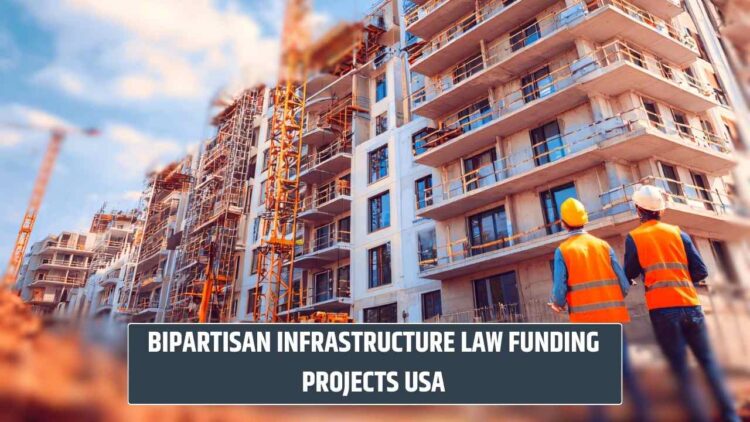The US government enacted the IIJA or Bipartisan Infrastructure Law in 2021 to upgrade the traditional infrastructure and fund the projects. The law has improved the American infrastructure through funding for new projects. Let’s understand the US Infrastructure projects funding through the IIJA 2021.
Bipartisan Infrastructure Law Funding Projects USA
The federal government has decided to invest $1.2 trillion in infrastructure projects through the Bipartisan Infrastructure Law. The law funded each infrastructure sector, addressing their needs. The government funded infrastructure projects through various grants and programs over five years.
The legislation includes investments to modernize and repair critical infrastructure assets in all 17 categories. Here, you can check the funding distribution for each sector from $1.2 trillion:
| Investment Sector | Funding |
| Power and Grid | $73 billion |
| Roads and Bridges | $110 billion |
| Passenger and freight rail | $66 billion |
| Water | $55 billion |
| Broadband | $65 billion |
| Resiliency | $46 billion |
| Airports | $25 billion |
| Ports and Waterways | $17 billion |
| Environmental Remediation | $21 billion |
| Transit | $39 billion |
| Safety | $11 billion |
| EV Infrastructure | $7.5 billion |
| Low-carbon buses and ferries | $7.5 billion |
According to the IIJA funding status as of July 2025, the Department of Transportation has spent $431.8 billion, where $305.2 billion was committed to projects and $169.3 billion was paid out. The government funded the infrastructure through various departments, grants & and programs.
Common Infrastructure projects funded via Bipartisan Laws
With the Bipartisan Infrastructure Law funding, thousands of infrastructure projects in all categories have been started and received funding. Here we have curated the list of the major infrastructure projects under the law, improving the American Infrastructure:
22nd Street Revitalization Project
- The project replaces a 1960s bridge with a new Union Pacific Railroad and State Route 210 in Tucson, Arizona.
- The project received the funding through the RAISE Grant, which also expanded 22nd Street to six lanes from four lanes.
Terminal Island Rail System Project/ Maritime Support Facility Access
- This project was initiated at the Port of LA, California, where $20 million was used from the RAISE Grant to build a four-lane, railroad separation grade that will reduce the traffic at the port and eliminate accidents.
- This port handles 35% of Waterborne containers coming into the country, hence it’s important to reduce the delays.
PanBowl Lake Corridor Project
- The Panbowl Lake Corridor Project at Jackson, Kentucky, has received the $21 million RAISE grant to improve the KY15 and strengthen the earthen dam to protect the people from floods.
- The corridor will expand with bike lanes, sidewalks, and other features that will help in mitigating the traffic and improve mobility.
I-1375 Community Reconnection Project
- This project will reconnect the two neighborhoods divided from downtown Detroit’s main business through highway construction.
- The funding for this project is $104 million under the INFRA grant to improve the transportation and upgrade the existing infrastructure with more safety measures, and use innovative smart traffic management ways.
Renewing Berlin Renewable Energy Project
- The project gets the $19 million RAISE grant to install a snowmelt system, where the nearby biomass plant will be used for heat and to improve the energy access for the residents in winter.
- This also has municipal parking areas, road rehabilitation, and other pedestrian safety improvements to improve public safety.
The most funded sector through the IIJA is the transportation sector, including airports, buses, EVs, railways, public transit, highways, and more. The federal government has funded many projects that will enhance each sector and improve the American infrastructure.
How did the Bipartisan Infrastructure Law fund the infrastructure projects?
The federal government funded Infrastructure projects through the Bipartisan Infrastructure Law funding in different mechanisms through the federal programs or grants, or distributed the funds to state funds.
The infrastructure projects in the USA were funded through formula-based or competitive grants to states or federal agencies. Here, you can understand the funding mechanism of the IIJA 2021:
- Formula funding:
- Here, the funds are distributed based on the set formula under the law, which decides whether the entity will receive the funds or not, and if eligible, how much they will receive.
- Competitive Grant:
- Here, the awardees are selected from the various applications based on the review process, based on the fixed eligibility criteria, project proposal, and other factors.
- Project Grant:
- This is for a certain special project or initiatives that will be awarded to government agencies, private companies, or non-profit organizations, etc.
- Under DOT, the BIL is funding $105 billion in infrastructure projects.
- State Revolving Fund:
- The SRF offers grants and low-interest rate loans for public infrastructure, such as water repair, building, and sanitation.
- Two SRF programs are funded through the law, such as Drinking Water SRF and Clean Water SRF.
What is the impact of the BIL funding on infrastructure projects?
According to the BIL, the funding was provided to the infrastructure projects through various grants and programs. You can see the results as ASCE graded the infrastructure with a C grade in the 2025 Report Card. Here you can see the impact of the BIL funding:
- The US bridges’ poor condition has declined to 6.8% in 2024 from 7.3% in 2020, and some roads have been improved from mediocre condition to better.
- The law invested $616 million in 238 projects to preserve the watersheds through various watershed programs.
- The law focused on resilience infrastructure and building infrastructure that can adapt to climate change and secure public safety and government funds.
- The law invests in electric vehicle chargers nationwide to support green transportation.
- The law created various jobs in construction and other infrastructure-related fields that have ultimately improved the nation’s economy.
With the BIL, the US infrastructure is improving, but the major concern is that in 2026, the funding will end. And to continue this infrastructure growth, we need to ensure long-term investment.



